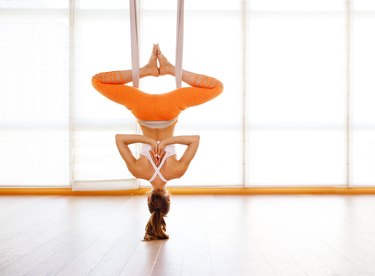
Inversion tables have been promoted as an option for helping with everything from back pain to migraines. But do inversion tables really work to reduce pain and improve chronic medical conditions? Here's what you should consider before testing gravity.
Read more: How to Properly Use an Inversion Table
Video of the Day
Video of the Day
The Purpose of Inversion Tables
Inversion therapy uses a rotating table or special gravity boots to allow you to hang upside down. That uses gravity to help reduce pressure on the muscles, nerves and bones of your back. "It's good for a quick stretch upside down to relax muscles, decompress the spine and provide temporary back pain relief and flexibility," says Stephen Liu, MD, an orthopedic surgeon in Beverly Hills, California, and founder of IFGfit.
Inversion therapy benefits have been shown to reduce lower back pain by relieving pressure on the sciatic nerve. "Sciatica is a condition that results when the sciatic nerve becomes irritated somewhere along its path," says Andrea Shakarian, DC, a chiropractor with Wagner Holistic Center in Pacific Palisades, California.
"If the cause of the sciatic pain originates from the L4 or L5 vertebral disks being herniated or from nerve impingement at those levels, then inversion traction therapy will allow the disks to decompress and relieve irritation of the sciatic nerve," Shakarian says.
Some doctors have also suggested using back inverters for migraine prevention. "Migraines are a vascular type of headache," Shakarian says. "Research has shown that during a migraine attack, the blood in the brain is depleted in oxygen. Inversion therapy floods the brain with more blood flow and thus more oxygen. I would recommend inversion therapy more as a preventative treatment for migraines rather than a means of treatment during a migraine attack."
And of course, some people use inversion tables for fitness, not medical treatment. Attempting to do abdominal exercises like sit-ups and crunches on the table increases the difficulty, forcing the core muscles to work harder to lift up from a steeper angle. But there's no research to support this use or its safety.
Inversion doesn't require a large investment time — just one to two minutes, twice a day is all you should do on an inversion table, according to Dr. Liu. To use the inversion table, simply secure yourself to the table, and slowly turn upside down to the appropriate degree.
Do Inversion Tables Really Work?
While inversion therapy may be helpful in healing short-term back pain and issues in some people, clinical studies have shown mixed results when it comes to long-term spinal health.
A small study published in January 2012 in the journal Disability and Rehabilitation involved 24 people with lumbar disease who were randomly assigned to either inversion treatment and physiotherapy or physiotherapy alone. The researchers found that inversion treatment at about 60 degrees for six weeks reduced the need for back surgery. However, Mayo Clinic says other studies on the effects of this type of treatment concluded that inversion doesn't help over the long term.
And while simply hanging upside down seems like it would be a relatively mild treatment, inversion is not without risks. It can result in muscle spasms that cause more pain, and the change in blood flow could increase your blood pressure and slow your heart rate, making it dangerous for people with hypertension or other issues, says Shakarian.
In at least one case, reported in March 2017 in the journal Cureus, the pressure from inversion was implicated in two separate instances of retinal detachment in one person. The risks of these unintended side effects increase if you spend longer than recommended in the inverted position.
The bottom line: If you have a backache, don't be tempted to head out and buy this on your own. "Consult with your doctor or physician to make sure you're a healthy candidate and that you'll benefit from the therapy," Shakarian says.
- Disability and Rehabilitation: “Inversion Therapy in Patients With Pure Single Level Lumbar Discogenic Disease: A Pilot Randomized Trial”
- Mayo Clinic: “Does Inversion Therapy Relieve Back Pain? Is It Safe?”
- Cureus: “Bilateral Retinal Detachments Associated with Inversion Table Therapy”
- Andrea Shakarian, DC, chiropractor, Wagner Holistic Center, Pacific Palisades, California
- Stephen Liu, MD, orthopedic surgeon, Beverly Hills, California, and founder, IFGfit
Is this an emergency? If you are experiencing serious medical symptoms, please see the National Library of Medicine’s list of signs you need emergency medical attention or call 911.